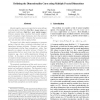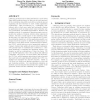167 search results - page 16 / 34 » Constraints for closest point finding |
ICDE
2000
IEEE
14 years 9 months ago
2000
IEEE
Nearest neighbor queries are important in many settings, including spatial databases (Find the k closest cities) and multimedia databases (Find the k most similar images). Previou...
ICDE
2011
IEEE
12 years 11 months ago
2011
IEEE
— How similar are two data-cubes? In other words, the question under consideration is: given two sets of points in a multidimensional hierarchical space, what is the distance val...
ICCV
2003
IEEE
14 years 10 months ago
2003
IEEE
Our paper addresses the problem of enforcing constraints in human body tracking. A projection technique is derived to impose kinematic constraints on independent multi-body motion...
DAARC
2007
Springer
14 years 2 months ago
2007
Springer
In a questionnaire study the effects of discourse structural information on resolving inter-sentential anaphora were investigated. The Right Frontier Constraint, first proposed by ...
KDD
2007
ACM
14 years 8 months ago
2007
ACM
Clustering methods can be either data-driven or need-driven. Data-driven methods intend to discover the true structure of the underlying data while need-driven methods aims at org...


